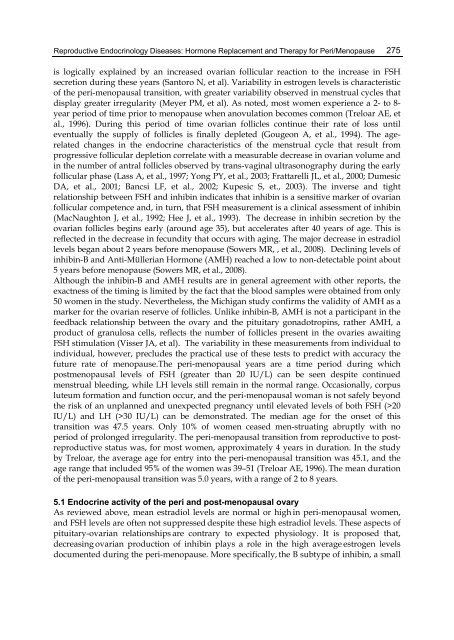ARTIFICIAL INSEMINATION IN FARM ANIMALS - Phenix-Vet
ARTIFICIAL INSEMINATION IN FARM ANIMALS - Phenix-Vet
ARTIFICIAL INSEMINATION IN FARM ANIMALS - Phenix-Vet
Create successful ePaper yourself
Turn your PDF publications into a flip-book with our unique Google optimized e-Paper software.
Reproductive Endocrinology Diseases: Hormone Replacement and Therapy for Peri/Menopause 275is logically explained by an increased ovarian follicular reaction to the increase in FSHsecretion during these years (Santoro N, et al). Variability in estrogen levels is characteristicof the peri-menopausal transition, with greater variability observed in menstrual cycles thatdisplay greater irregularity (Meyer PM, et al). As noted, most women experience a 2- to 8-year period of time prior to menopause when anovulation becomes common (Treloar AE, etal., 1996). During this period of time ovarian follicles continue their rate of loss untileventually the supply of follicles is finally depleted (Gougeon A, et al., 1994). The agerelatedchanges in the endocrine characteristics of the menstrual cycle that result fromprogressive follicular depletion correlate with a measurable decrease in ovarian volume andin the number of antral follicles observed by trans-vaginal ultrasonography during the earlyfollicular phase (Lass A, et al., 1997; Yong PY, et al., 2003; Frattarelli JL, et al., 2000; DumesicDA, et al., 2001; Bancsi LF, et al., 2002; Kupesic S, et., 2003). The inverse and tightrelationship between FSH and inhibin indicates that inhibin is a sensitive marker of ovarianfollicular competence and, in turn, that FSH measurement is a clinical assessment of inhibin(MacNaughton J, et al., 1992; Hee J, et al., 1993). The decrease in inhibin secretion by theovarian follicles begins early (around age 35), but accelerates after 40 years of age. This isreflected in the decrease in fecundity that occurs with aging. The major decrease in estradiollevels began about 2 years before menopause (Sowers MR, , et al., 2008). Declining levels ofinhibin-B and Anti-Müllerian Hormone (AMH) reached a low to non-detectable point about5 years before menopause (Sowers MR, et al., 2008).Although the inhibin-B and AMH results are in general agreement with other reports, theexactness of the timing is limited by the fact that the blood samples were obtained from only50 women in the study. Nevertheless, the Michigan study confirms the validity of AMH as amarker for the ovarian reserve of follicles. Unlike inhibin-B, AMH is not a participant in thefeedback relationship between the ovary and the pituitary gonadotropins, rather AMH, aproduct of granulosa cells, reflects the number of follicles present in the ovaries awaitingFSH stimulation (Visser JA, et al). The variability in these measurements from individual toindividual, however, precludes the practical use of these tests to predict with accuracy thefuture rate of menopause.The peri-menopausal years are a time period during whichpostmenopausal levels of FSH (greater than 20 IU/L) can be seen despite continuedmenstrual bleeding, while LH levels still remain in the normal range. Occasionally, corpusluteum formation and function occur, and the peri-menopausal woman is not safely beyondthe risk of an unplanned and unexpected pregnancy until elevated levels of both FSH (>20IU/L) and LH (>30 IU/L) can be demonstrated. The median age for the onset of thistransition was 47.5 years. Only 10% of women ceased men-struating abruptly with noperiod of prolonged irregularity. The peri-menopausal transition from reproductive to postreproductivestatus was, for most women, approximately 4 years in duration. In the studyby Treloar, the average age for entry into the peri-menopausal transition was 45.1, and theage range that included 95% of the women was 39–51 (Treloar AE, 1996). The mean durationof the peri-menopausal transition was 5.0 years, with a range of 2 to 8 years.5.1 Endocrine activity of the peri and post-menopausal ovaryAs reviewed above, mean estradiol levels are normal or high in peri-menopausal women,and FSH levels are often not suppressed despite these high estradiol levels. These aspects ofpituitary-ovarian relationships are contrary to expected physiology. It is proposed that,decreasing ovarian production of inhibin plays a role in the high average estrogen levelsdocumented during the peri-menopause. More specifically, the B subtype of inhibin, a small










